
A left over is normally related to food: a left over from a meal. It ends up in a tupperware container or ziplock bag in the freezer or fridge until reheated and consumed. In a restaurant you left overs end up in a doggy bag to bring back home and eat later. We introduce a new variant here: a blog filled with the New Zealand left overs. We have a list of things we like to do or see and there are not many days left.
We arrived too early in Queenstown; next week can we pick up a motorhome to drive it to Auckland in one go. Until then we still have about six or seven days and our plan is to cycle a so-called Great Ride, this time the "Around the Mountains Trail", which has - according to the brochures - one of the most fantastic scenery in New Zealand. We want to combine that with a trip to the town of Te Anau and (a tour to) the New Zealand fjords Doubtful Sound or Milford Sound.
We got up early because it will rain in the afternoon and are completely ready for departure for quiet a while. Setting off is not easy today and we make another cup of coffee. Bad weather is expected not only for the afternoon but for the entire coming week: cold, strong headwinds and lots of rain. Yes, we are struggling with serious motivation problems to do this to ourselves. Yes, call us nice-weather cyclists. We do indeed like the sun and tourist-brochures always show beautiful sunny photos, even from places where rain falls more than three meters a year and it rains two of the three days. Never of shivering grumpy people with rain coats over their down jackets and bad hair and that everything around them is colored gray and concealed in clouds. And, beside that, we already have reached our final goal: Queenstown. To summarize a lot of considerations: the same day we rent an absurdly cheap and brand new car to increase the chance of making "pica's" from the undoubtedly beautiful area around Queenstown. Our plan to take the bikes with us fails if it appears that they do not fit in the car without seriously damaging it. This way our titanium steeds get a well-earned rest in the garage of the campsite where we spent the night. The plan? We have a list of the left overs to see and experience, and the weather forecast determines which ones we will actually consume in the coming days.
Highly noted on that wish list are the fjords of Milford Sound. We would like to visit them, despite the expected "annexation" by tourists from China. It was too far and, moreover, dangerous to cycle towards it. We would have to book something from a tour anyway. Doubtful Sound, the fjords at the town of Te Anau is not that popular with the Chinese and would be a nice alternative were it not that the tours are quite pricey. So we are heading directly to Milford Sound in our rental because the weather forecast is whispering that to us today. It is a 4-hour drive and the road to it, especially the last 10 kilometers, absolute stunning: steep to straight mountain walls with (fresh) snow on top and everywhere, really everywhere, water falls down. It is one big waterfall around us. Along the way and back we stop here and there for example at a "Mirror Lake" where the mountains would reflect if it were not full of aquatic plants and there was no (stormy) wind. And we stop at a roaring river where a beautiful Kea, the bolt and naughty parrot-like bird that lives in here in the highlands, gnaws the roof channel of our rental car. Harry drives him away with difficulty, after which he deliberately destroys the rubber window frame of the parked car behind us. Roelie tries to scare him away, but apparently makes even less impression on this Kea. We wish the car behind us a lot of strength and continue our way.
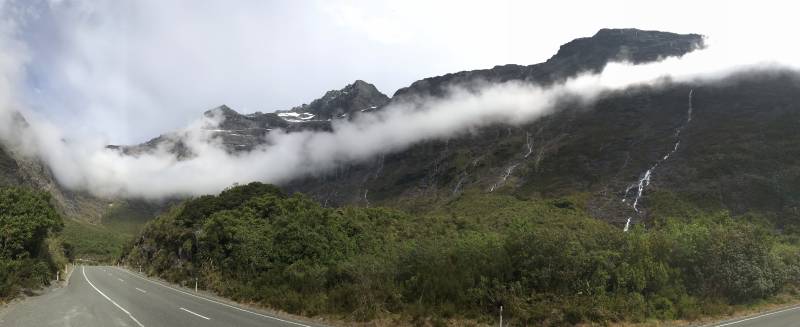

The car-eating kea cannot be chased away

The rental car

The road between Te Anau & Milford Sound
When we come out of a one-lane tunnel on the other side of a mountain range, even a bit of sun pricks gently through the clouds and the masses of Chinese are probably already in a bus or boat because there are almost no people in Milford Sound. Our jaws are now pretty much dropping till they meet the dashboard: how indescribably beautiful it is here and how privileged we are to be here now!
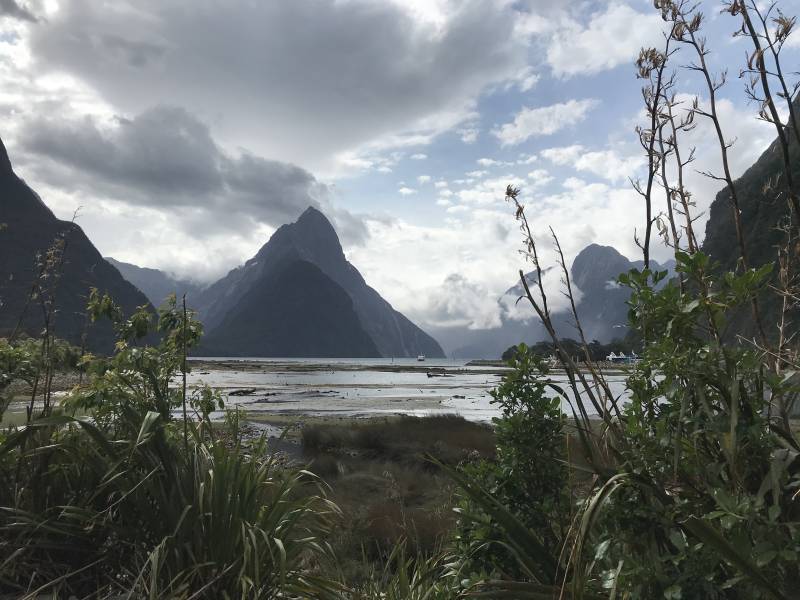
Milford Sound
On the way to all this beauty, we have already visited a number of camping sites of the DOC, a government department. They are relatively expensive, while they offer nothing more than a smelling drop toilet. Only one, the Cascade Creek campsite, offers more: an enormous open ground where in many colors the lupins grow in the strip between a wild stream and the forest, a beautiful view of the mountains around us and a shelter under which we can cook as it is going to rain. We agree to return to this place for the night.

Cascade Creek campsite
In the evening it is fortunately still dry and we keep the hordes of bloodthirsty sand flies at bay by covering us up in a cloud of insect repellent with a large percentage of DEET. During the night it rains steadily but by the morning it is almost dry and the sun comes out. The tent is already starting to dry up in the still strong wind. We decide to go to the shelter to have breakfast out of the wind and drink coffee in the hope of being able to put a completely dry tent in the car but it starts to drip and rains harder and harder until it starts really to pour. An hour or so later we break down the tent in still pouring pouring rain and throw a soaked rag in the car. We return to civilization with mobile internet reception to see where the weather forecast takes us.
At the Te Anau i-site, which is the name of the tourist office here in NZ, we ask what our options are. After our lightning visit to Milford Sound there are high on our wish list: 1) a Great Walk walk, being the most beautiful multi-day hiking trails in New Zealand and 2) the glaciers Fox and Franz Josef, but for which we know, several roads are still closed due to the persistent bad weather. The lady behind the counter has good and bad news for us: the hiking trails are all open and the road is only closed behind Franz Josef, so these left overs can be tasted. The bad news: the weather forecast is awful! We ask if this tourist office, because of the continuous rain, advises negatively on which the lady laughs: "in Te Anau it rains more than 200 days a year and a wet suit is considered a given". Tough language of this lady, who offers us brochures containing only sunny pictures of these totally rained out areas. But still good to adjust our mindset: this left over should not be warmed up, but diluted!
The option to walk for several days nevertheless appears to be difficult. In New Zealand they call multi-day walking tramping, which in our opinion evokes other associations (with "the lady is a tramp" they do not mean that the lady is a multi-day walker), but that entirely aside. Camps and huts or better dormitories are located on the hiking route for overnight stays. On these very popular walking routes all bunk beds in the cabins appear to be fully booked and the camping sites are illogical situated and are too far apart for walkers. We are a bit surprised that the cabins with bunk beds are fully booked. Not just for tomorrow but for much longer and wild camping is absolutely not allowed. By the way, dear DOC-department, how dare you ask NZ $ 130 per person (double rate for foreigners, almost € 80 or US$ 90 and therefore far above our daily budget) for a dormitory with 40 bunk beds without a shower, etc? And how would the long distance hikers of the Te Areroa, the four-month trail from Cape Reinga in the far north to Bluff in the far south, do that? They will not (and cannot) reserve this in advance, if they can already afford it? Anyway, for us, it means that we limit ourselves to a, in itself, tough day walk on the Kepler Track from Te Anau.
The Kepler trail is highly appreciated on the internet of the Great Walks and in retrospect we find that absolutely not strange. We walk through a magical rainforest and imagine ourselves in fairyland. It seems that scenes of "Lord of the Rings" have been recorded here. Halfway, we are almost at the place where we will turn again, we walk briefly above the tree line and see the snowy mountains of the Fjordland National Park in a 360 degree view and look down on Lake Te Anau and Lake Manapouri from above. It is raining very lightly, the sun is shining and the wind is blowing hard when we mop up our own sandwiches on top of the mountain.
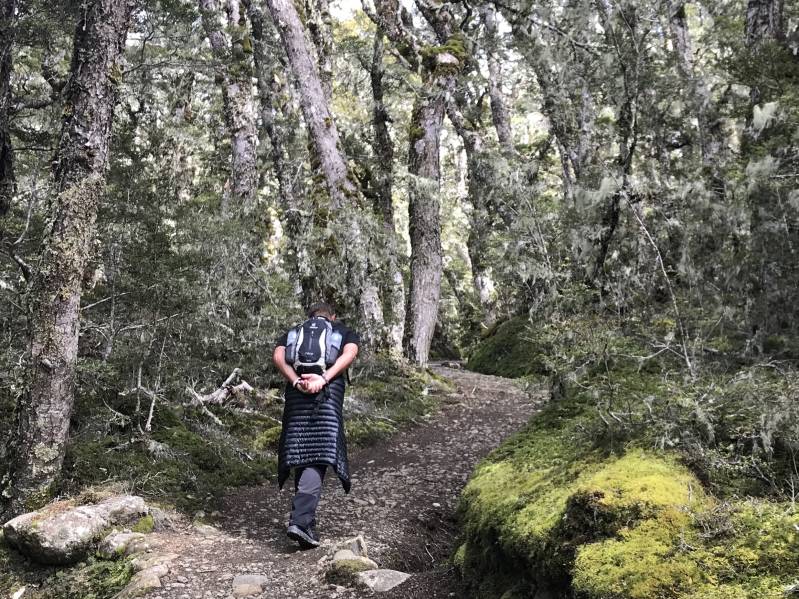


All Kepler trail
Right at the start of the descent, Harry's thigh muscles are protesting and a whip-like cramp strikes. He can hardly walk and we suspect that it will be a very long way back. After that his soles also hurt a lot and after that he just went through it. Roelie also has pains, but you don't hear them. What a wonderful woman that is and she drags and supports her husband down with love ...
Ho wait a minute, this blog has largely sprouted from Roelie's pen, but here I - Harry and this time responsible for fine grinding and editing - still have to break in and let the truth be blessed! So: ... due to the constant headwork, the carrying of provisions and water supplies and the towing of his lovely wife 1000 meters uphill, the impressive thigh muscles of Harry have become overloaded and they fall downhill in an abnormal cramp. Roelie offers to take over the now empty(!) backpack from him. Regardless of the fact that hiking is by no means "his thing", he continues without grumbling towards the (for him) desired goal of this day: the car in the parking lot.

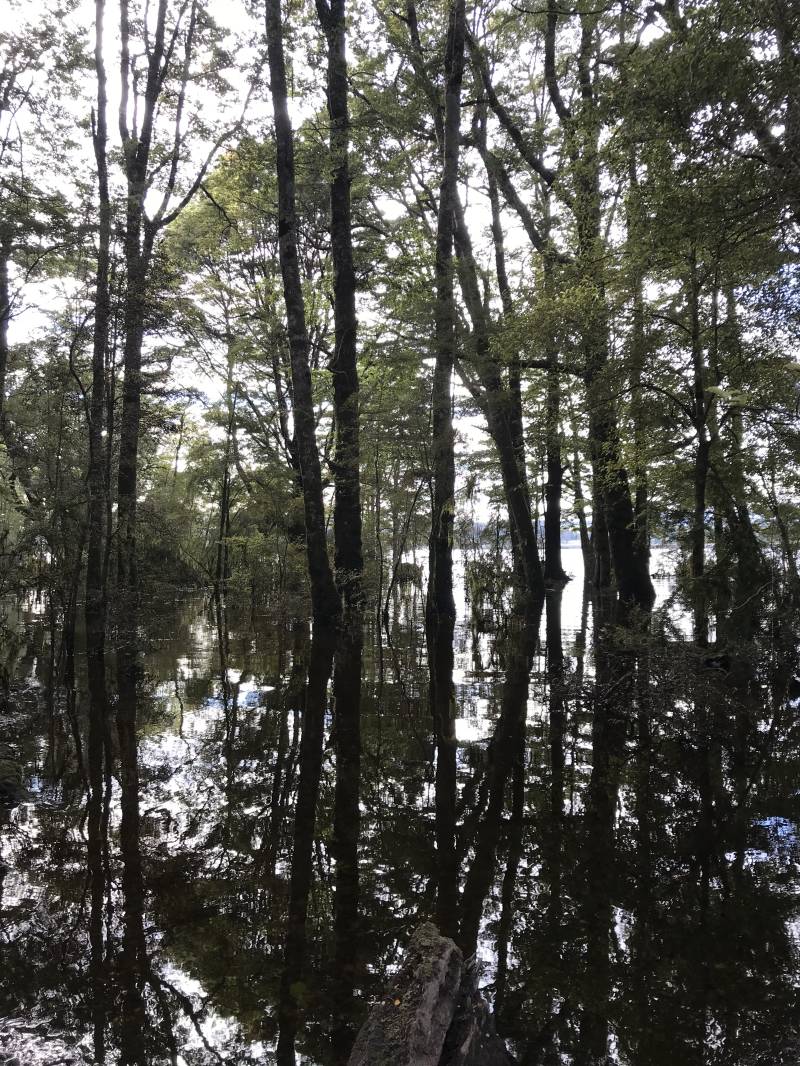
More Kepler trail
The upcoming rain and the unavoidable muscle pain we sit out the next day in the Ophir Lodge where we have been before when we cycled the Otago Rail Trail. While a wood stove keeps us warm and the rain is ticking on the roof, we are sitting in a large cozy kitchen and watching the four-part Hugergame film series on Netflix. The only other guest is Hanna from Germany and she is enjoying with us. We are even slightly jealous when Hanna decides to spend another day. We leave and drive through the rain to Wanaka, also a left over. For Wanaka, good weather is predicted for tomorrow and we want to make maximum use of it. Unfortunately, the weather at the Fox and Franz Joseph glaciers is still too bad.
In the cloud-covered Wanaka, we check with the i-site whether the Rob Roy Glacier Trail is open. This left over has become a favorite after some internet research and we still see a glacier. Unfortunately, both the road and the trail there are closed. The i-site mentions the Ishtmus Trail as the best alternative. Nice! The next morning the clouds are almost gone and we see how beautiful the surroundings of Wanaka really are. Everywhere high peaks with fresh snow at that at the start of the New Zealand summer. The drive to the starting point of the Isthmus Trail along Lake Hawea is incredibly beautiful. There is only a small parking lot and there are just two other cars parking. There is nobody else, we are really looking forward to it. We're looking forward to another 6 hours of walking with stunning views. A young man who leaves just a little earlier, however, soon comes back. We look at him in surprise and are told that the trail is closed due to fawning, which apparently has something to do with newborn deer. It's a big bummer because the only remaining day stage is Roys Peak, which is busiest and should be quite boring. Moreover, we still have to drive a lot and it is getting quite late to start the climb. On the way back we pass another very simple and popular trail: Mount Iron of only 1.5 hours and we decide to walk it. Oh well, crowded but just super beautiful.
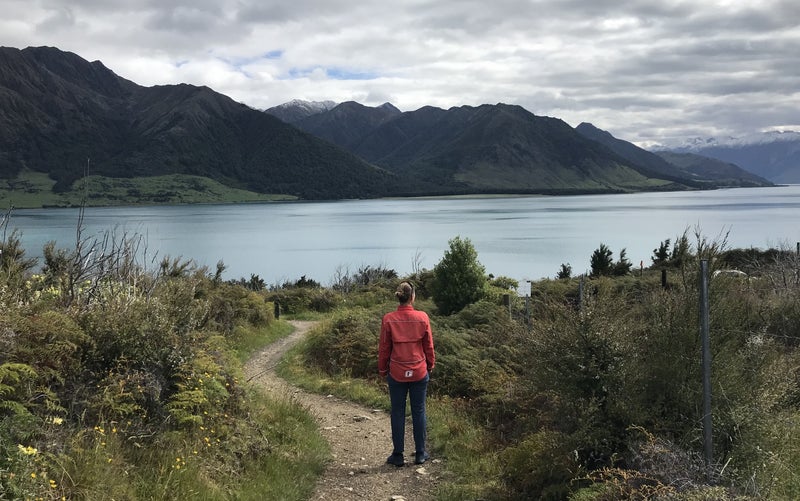
Start of the Ishtmus Trail which was close due to fawning

View from Mount Iron

Mount Iron trail
From the campsite we walk to #thatwanakatree, a 70 year old tree in Lake Wanaka and a challenge for photographers to post their best images on Instagram. The tree is in the water halfway up the crown and a nice photo cannot be made, but of course we do an amateur attempt with our iPhone.

#thatwanaketree
We evaluate New Zealand while walking to this this tree in the lake. Yes it is wonderful but ... on the bike it is quite dangerous. We have cycled seven Great Rides. Three of them (Hauraki, Te Ara & Otago) were pretty boring for the most part and "Around the mountains", which we wanted to cycle, also looked boring from the rental car when the trail ran parallel to the highway for tens of kilometers. The other four (Great Lake, Timber, Alps2Ocean & Queenstown) were awesome. The trails and routes are not easy to cycle one after the other and that means that we often had to cycle on main roads that are downright dangerous. The traffic is really a thing here in New Zealand. It is not busy on the roads and that is why it is common to drive too fast here, which is also allowed (at least up to 100 km/h), but then we are not talking about the 6-lane Dutch straight highways, but about narrow, winding, mountainous roads often without a shoulder. Despite all the 'Share the road' signs and signs with the mandatory distance between cyclist and car (1.5 meters) - in our eyes the most ignored traffic sign in New Zealand - traffic rushes too fast and too close to you and that gives you a very uncanny feeling. And let's be clear: a significant proportionof the New Zealand drivers believes that cyclists do not belong on the road...

The unruly weather in New Zealand has been very decisive, at least for us. We knew beforehand that it rains a lot here and as a result everything is beautifully green, wildflowers adorn the verges and the yellow broom the gorges of rivers. But the rain is also cold and worse, it is accompanied by low-hanging clouds so that sometimes whole days nothing, but also nothing at all, can be seen of the beautiful surroundings. But at the end the wind has plagued us more than the rain.
We must also note that we have little contact with New Zealanders. The country is so incredibly popular among tourists. There are probably more foreigners on the islands than the country has residents and the natives will all suffer from tourist fatigue. It is nice that we have come across many other long-distance cyclists: from Belgium 1, Germany 3, France 2, Slovakia 1, Argentina 2, Australia 2, Japan 1 and Taiwan 1. And yes, indeed: New Zealand 0 ( they know better ...).
What is our final opinion? In terms of best cycling country so far, after 28 countries? Turkey remains at 1.

Seen at a petrol station: a dog wash with the choice of soft shampoo or anti-flea shampoo, conditioner and blow dry
At the airport in Queenstown we return the car and pick up the motor home. The bicycles in the garage of the campsite are awakened from their sleep and may continue to rest in the spacious camper. We drive (chronoligically) in one half, one whole, one half and finally one three-quarters day to Auckland and that is pretty much a snap. For the first day we have planned a big stretch but get a bit sleepy soon and decide to stop at Lake Pukaki at the end of the afternoon. Along the lake only so-called "self-contained vehicles" may spend the night. That too has become a minor annoyance for us cyclists. There are many beautiful camping spots in New Zealand, but they can only be used by campers with a "self-contained" sticker indicating that all waste can be collected: a toilet, a water system with running water and a waste bin with a lid. Quite a few so-called space cars are driving around with the seats in the back exchanged for a mattress that is also such a sticker and it is absolutely clear to everyone that the people who drive there do not use the "toilet" or the "flowing water system". Wild camping is not allowed, so for us the bicycles with the tent are left with the often rather expensive camping sites and we have to cycle past those wonderfully beautiful places where often a toilet is also available. Perhaps unintentionally, the government of New Zealand is frustrating travelers who want to travel through the country in a clean way, instead of a rental car, space car, camper or motor home. Now that we have a motor home, free camping is possible.

The motorhome to relocate @Lake Pukaki
At Lake Pukaki are undoubtedly the most beautiful designated camping spots of New Zealand situated and it's free! The next day we drive a total of 10 hours of which the last 8 due to the pouring rain. We find a camping spot 10 minutes from the ferry to the North Island and again park our self contained vehicle for free in a great place with picnic tables and a great toilet block! And again: prohibited for cyclists with a tent...
We get up in a dense fog in the morning and, to our surprise, we drive out of the fog in that short stretch to the harbor of Picton. Again we enjoy the beautiful crossing, as if it is rougher than a month ago: various people have to use the omnipresent puke bags.

The ferry from South to North Island through the Marlborough Sound
In the afternoon we try to get as far as possible on the North Island. When we see the inactive volcanoes of Tongariro National Park (the site of the popular Great Walk Alpine Crossing), we drive past a campsite behind a military museum. A place with a great view and again for free, if ... yes you know it by now. Unfortunately, clouds quickly form around the volcanoes and less and less of them can be seen, but the clouds are completely gone the next morning. With a clear view of the amazing volcano tops, pinned with eternal and newly fallen snow, we begin the last part to Auckland.

Caravan parking behind the Army Museum with view on the volcano Mount Ruapehu (Tongariro National Park)
Upon arrival in Auckland, we have six days left until our flight to Buenos Aires, to the second half of our three-year #worldbybike tour. In those remaining days we set our sights on one last GodsOwns left over: Coromandel, a peninsula two hours from Auckland. The bicycles can be taken on the crossing for free. What a wonderful word that is (especially for Dutch people): free.

Ferry from Auckland to Coromandel
We do a small Christmas-tour for three nights with a big amount of altitude meters. We take a walk here and there and end up on New Chum Beach (the 6th most beautiful beach in the world), Cathedral Cove (limestone coast), Hot Water Beach (hot pools on the beach to dig at low tide) ) and Square Kauri (a 1200 year old tree, finally something really historical, hahaha). Beautiful landscapes, nice weather and an extremely low Christmas feeling, which even falls below freezing point on the morning of Boxing Day when it appears that someone has stolen our socks and Roelie’s brand new cycling shorts from the clothesline at the campsite in the night. A French couple has lost their towels and, like us, walks around the campsite in vain. How sad!

Tide water caravan park Coromandel Town

Recover from the first tough climb

New Chum Beach, no 7 most beautiful beach in the world
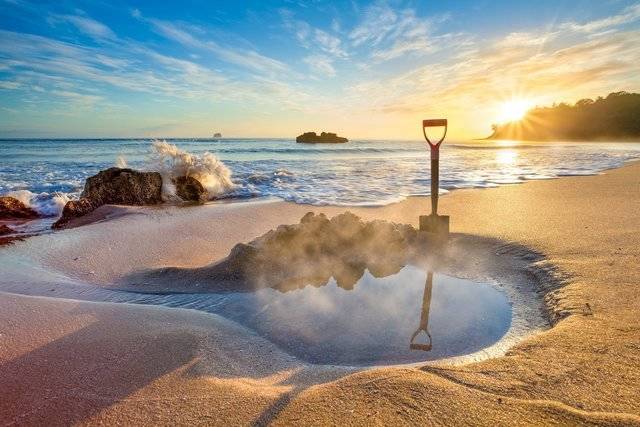

At low tide you can dig your own hot pool on Hot Water Beach. First a photo that is used in all brochures first and then a pica of the reality


Cathedral Cove

Tapu - Coroglen road

On the ferry at Whitianga on Christmas

The Square Kauri, an estimated 1200 year old Kauri tree with a somewhat square trunk (and no, Harry is not peeing against it ;-)

Tapu - Coroglen road

Cyclists Gerard and Klasina on the same ferry back to Auckland
Back in Auckland we have one day left - and this city fortunately has a lot stores - to prepare ourselves for the sequel: South America. We have to do quite a bit: of course, new socks and cycling shorts, but also a new storm-proof and leak-proof tent and a multi-fuel burner. The boxing day sales have started and we score quite a bit of discount. Even though it is just not Christmas anymore, we are very happy with the purchases we give each other as gifts for our 12 year old relationship last December 12, Christmas and Harry's birthdays on January 6. The new tent is a lot smaller and narrower than our previous one, hopefully our marriage will withstand it and we will have the 10th wedding anniversary in June ...
We dismantle the bikes and board the plane to Buenos Aires for the second half of the world trip. Aboard our time machine (we leave after 8 o'clock in the evening, fly more than 10 hours and still arrive in Argentina four hours earlier that day), in between episodes of season eight of “The Game of Thrones” we find some time for a short reflection: We look back on New Zealand with mixed feelings: so beautiful, so unreal, but also with unsafe roads for long-distance cyclists and the population is invisible (or are they visibly tourist-tired but also economically highly dependent on the tourist industry). In any case, we have absolutely no regrets that we came here, it really is a very beautiful country and we have seen so much of it. Bit very strange, for the first time we faced (in lightweight form, but still) some motivation problems for unknown reasons: was it because the previously described insecurity on the road, was it because we knew that we had to return to Auckland again, was it because of the choice stress in terms of route options, was it the determining and sometimes disastrous weather (as a result of which, for example, we were unable to admire the glacier of our dear friend Frans Jozef), or was it that we felt more tourist than traveler, and / or that the most beautiful places turned out to be the biggest tourist traps ...?
Roelie: “O my gosh we are halfway ...I don't want to start to count down, do you? ”
Harry: "No, certainly not! We'll learn some Spanish this next week. And I can already order two beers or two white wines in Spanish and furthermore we just have say "gracias" and "por favor" a lot: we'll manage all the way to the States in 2021, won't we...?"
Roelie: "Si! Vamos!"

